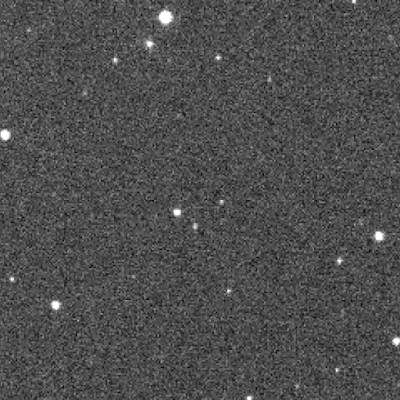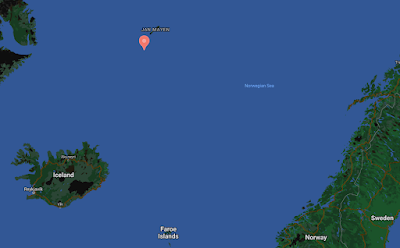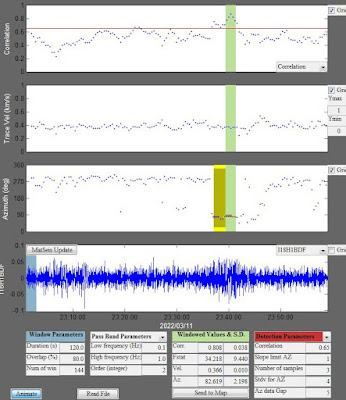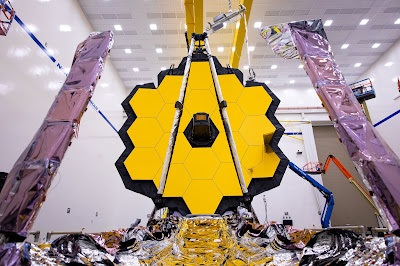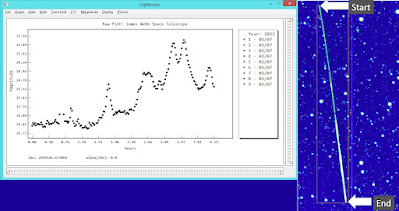On 2022 November 19.2, D. Rankin found a small asteroid using the 1.5-m reflector + 10K CCD of Mt. Lemmon Catalina Sky Survey (G96 MPC code) that was soon after put on the NEOCP list with the provisional designation C8FF042 for the follow-up by other observers. The Minor Planet Center subsequently assigned the following official designation to this object, 2022 WJ1.
Richard A. Kowalski of CSS at 06:20UT of Nov. 19 alerted on mpml mailing list "...it appears that this object (C8FF042) will impact around the Great Lakes region of the United States a few hours from the time of this message". According to Bill Gray the impact point was at 19 Nov 2022 8:26:54.47 UTC, lat +43.12309, lon W80.26416, directly over Brantford, Ontario, Canada.
Discovery images of asteroid 2022 WJ1
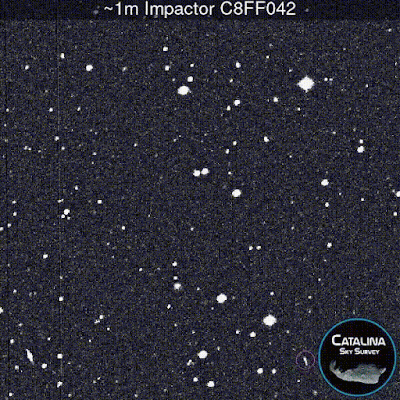 |
| Credit: Catalina Sky Survey |
M.P.E.C. 2022-W69 issued subsequently on 2022 November 19 at 14:14 UT assigned the official designation 2022 WJ1 to C8FF042 with the following comment:
D. Rankin detected a fast moving object in images taken at Mt. Lemmon Survey (G96). The observations triggered a warning of an imminent impact. Seven observatories were able to observe the sub-meter object before it impacted the Earth's atmosphere on Nov. 19 at approximately 08:27 UTC over Brantford, Ontario, Canada.
2022 WJ1 was a small Apollo asteroid with an estimated size of 0.5 m - 1.0 m (based on the object's absolute magnitude H=33.6).
This is the sixth time in history that an impacting object is observed prior to atmospheric entry. The first time it happened was with asteroid 2008 TC3, the second was with asteroid 2014 AA, the third was 2018 LA that impacted Earth on 02 June 2018, the fourth was with asteroid 2019 MO that impacted Earth on 22 June 2019 and the fifth was the asteroid 2022 EB5. Another space impacting object discovered prior to its to atmospheric entry was WT1190F but it is thought to have been a space debris, possibly the translunar injection module of Lunar Prospector. For more info about 2008 TC3, 2014 AA, 2018 LA, 2019 MO and 2022 EB5 see also:
http://remanzacco.blogspot.it/2008/10/small-asteroid-2008-tc3-to-hit-earth.html
http://remanzacco.blogspot.com/2008/10/2008-tc3-animation.html
http://remanzacco.blogspot.com/2008/10/2008-tc3-update-impact-flash-imaged.html
http://remanzacco.blogspot.com/2008/11/2008-tc3-trail-imaged-over-northern.html
http://remanzacco.blogspot.it/2009/02/2008-tc3-fragments-recovered.html
http://remanzacco.blogspot.com/2014/01/small-asteroid-2014-aa-hit-earths_2.html
https://remanzacco.blogspot.com/2018/06/small-asteroid-2018-la-impacted-earth.html
https://remanzacco.blogspot.com/2019/06/small-asteroid-neocp-a10eom1-impacted.html
https://remanzacco.blogspot.com/2022/03/small-asteroid-2022-eb5-neocp-sar2593.html
http://remanzacco.blogspot.com/search/label/asteroid%20impact
by Ernesto Guido











